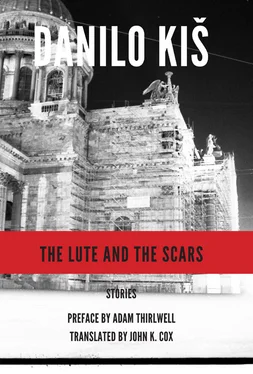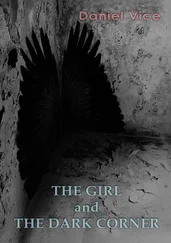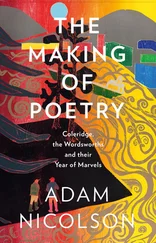Kiš first obtained translations of some of Horváth’s plays in 1970. These were the French versions that Gallimard published in 1967 (namely Italian Night, Don Juan Comes Back from the War , and Tales from the Vienna Woods ), prepared with an introduction that provided French readers with basic information about the life of this writer who had been utterly unknown up to that point. At this point Horváth began appearing in Kiš’s “warehouse” of emblematic figures and “themes for novels, topics for stories, parallels. ” But ten years would have to pass (this was the decade in which he wrote Hourglass, A Tomb for Boris Davidovich , and The Anatomy Lesson ) before the fate of this stateless man , which was attractive for reasons far exceeding mere literary interest, would again come to the front of Kiš’s mind. For it was in 1979 that Kiš began his ten-year long “Joycean exile,” at the end of which, as was the case with Horváth as well, came death in Paris. A further, external stimulus came from a recently published doctoral dissertation concerning history and fiction in Horváth’s dramas (Jean-Claude François, Histoire et fiction dans le théâtre d’Ödön von Horváth , Presses Universitaires de Grenoble, 1978). On an unnumbered page of the manuscript of “The Stateless One,” we find the following:
A story about the apatride or the Man Without a Country has been an obsession of mine for years. Actually from the time I read a short note in a magazine about his life and his tragic end. At first I had in mind writing some kind of retrospective or scholarly study about him. I wrote down a few observations, some of those naïve notes in which you conceal your own thoughts behind your characters. That was all really just appeasing my conscience and the creation of an illusion that notes like that are the beginnings of stories, their nuclei, the load-bearing beams of a future prose construction. But of course I got no further than that. And then one day I came across (by accident?) a PhD thesis that dealt with my stateless man. His character came back to life for me at once. And what did I find in this dissertation that related to my hero? A mass of useful information, dates, facts; but my story, my imaginary story atomized. The secret and mysterious atmosphere enveloping the life and death of my “hero” dissipated abruptly. But I nonetheless resolved to persevere, to try to bring back the atmosphere of secrets and the unknown. To write according to my own lights the bare-bones framework of facts, similar to a net of squares made of intersecting words.
(This passage, unchanged, could have formed part of a Postscript to The Encyclopedia of the Dead . It was probably written with that goal in mind.)
In manuscript form among Kiš’s papers were preserved seven tables of contents of a book of stories that would be published in 1983 under the title The Encyclopedia of the Dead . The first two, which we can trace without difficulty to the year 1980, included the title “Ödön von Horváth,” with a notation of the number of pages envisioned (ten in the first table of contents, and eight in the second). Both of the tables were written out by hand on half-sheets of typewriter paper. A remnant of cellophane tape attests to the fact that the list of titles (as if it were some literary duty) had been hung up in plain view somewhere. No tale involving Ödön von Horváth under any title, however, is to be found on the other five tables of contents, all of which were typed and which contain the titles of finished stories. We did, however, find forty-seven typed pages in Kiš’s papers belonging to a “topic for a story” about the life and death of an apatride . One of them bears the title “APATRIDE/MAN WITHOUT A COUNTRY,” typed in all capitals, and below that, in parentheses, “OUR HOMELAND IS THE MIND.” We used the first, underlined word as the title of the story, regarding the other two titles as variants. Among the forty-seven mostly uncorrected pages, we were able to discern two entities; their relationship to each other was one of first and second versions . The first consists of fourteen numbered pages, with traces of corrections, apparently carried out in one sitting, with a fine-point black pen. The story of the stateless man, now bearing the name Egon von Németh (the exchange of the surname Horváth for Németh, aside from purely literary concerns, which lie outside the scope of these notes, is interesting in its own right: one common family name used to designate Hungarians living along the borders to Croatian areas has been traded for an equally common family name for Hungarians from border areas next to German-speaking territory), flows continuously in this version, without any kind of breaks, even among sections that are chronologically very far apart. In the text, however, there are fragments, designated by numbers and circled in the same black pen, that later, with almost no changes, appear in the second version of eight pages.
This second version comprises fifteen numbered sections. There is no title on the first page, something that could mean that this version served above all as an investigation of the suitability of the form: the fragment as a structural unit is being put to the test. The question of structure is again of the greatest importance: the sequence of sections (“the texture of events”), their dimensions, the relationship between their relative lengths, interruption in the course of the narrative, and the nature of their graphic representations (characteristic here is the absence of long passages: every section has the semantic density of a stanza of poetry). At the top of the first and second sections there are, in addition, typed sentences taken word for word from scientific texts. A possible function of these quotes: the contribution to a sense of compression; but they have another, more important function: it is as if the author of A Tomb for Boris Davidovich wanted, through them, to say the following: “Look, ladies and gentlemen, what my starting point is, and look what it gives rise to, no matter how ‘carefully’ I exercise my ‘creativity.’”
What about the contents of the remaining twenty-five pages? For the most part unpaginated, they are largely variants of the passages included in the two versions already mentioned. But there are those that show “first-hand” traces of events from the life of the apatride that encompass his entire history. We took it upon ourselves, not without trepidation, to piece the story together (the fragmentary character of the second version made our work easier). We found justification in our desire to defy the irreversible.
Textual Notes:
entirely vague and pointless : Sentence incomplete.
And so forth : A passage for which we could unfortunately find no place in the unified and recomposed “variant,” given its similarity to this section/fragment, but could no more dispense with, on account of its function in the course of the narrative, is reproduced in its entirety here:
Here, in Amsterdam, in an isolated street a stone’s throw from a canal, our stateless man would suddenly find himself among his characters, a word that he used, not without attendant irony, every time his eye was drawn to those human creatures who bore on their faces or their bodies signs of rack and ruin, either patent or hidden. When night had begun its descent onto the streets, around the corner there would suddenly appear women, all dolled up, leaning against the wall in their tight, clingy dresses.
No more and no less so than other people. If he had been told this earlier, two or three years ago, he would not have paid any attention to it : These two sentences were omitted from the first publication of the story ( Srpski književni glasnik , 1, 1992).
Читать дальше












